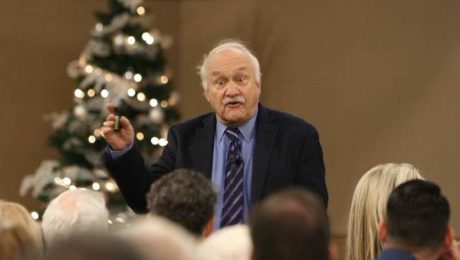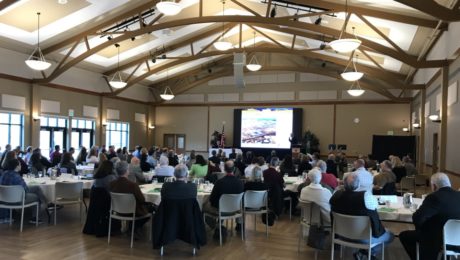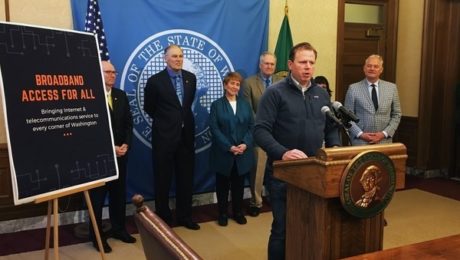First appeared on Washington Department of Commerce website on Dec. 17, 2019.
OLYMPIA, WA – Expanding on the success of its original economic gardening program, the Washington Department of Commerce has developed Thrive!, a new program to help second-stage companies increase revenues and position for growth.
Based on the Edward Lowe Foundation’s System for Integrated Growth (SiG) framework, Thrive! connects chief executive officers to subject matter experts who provide them with data, analytics, best practices and strategies that are typically only available to larger corporations. This actionable information can be used to overcome roadblocks related to human resources, finances, operations, marketing, sales, international trade and other business issues.
“Since its introduction three years ago, Commerce’s second-stage program has helped 39 businesses across the state find innovative ways to increase growth and revenue,” said Lisa Brown, Commerce director. “Where the original program focused solely on external issues, Thrive! examines internal and external roadblocks to growth, since one can often affect the other.”
Research shows that historically, companies that have completed a second-stage program like Thrive! experience a 15% to 30% increase in revenue.
The ideal candidate for Thrive! is a company that’s been in operation in Washington for at least two years, has between six and 99 employees, achieved $1 to $25 million in annual revenue and has demonstrated an appetite and aptitude to handle additional growth.
To help offset the $4,275 cost of the program, Commerce contributes $1,275 to pay for the initial needs assessment call with the team leader as well as a strengths-weaknesses-opportunities-threats (SWOT) analysis call with a team of experts assigned to address identified business issues. Based on these calls and the resulting work plan, the CEO can move into the research phase of Thrive!, which entails up to 33 hours of professional research time. Thrive! is conducted entirely by phone and a secure online portal created especially for each participating company. Thrive! requires approximately eight to 12 hours of the CEO’s time over the course of four to eight weeks.
More information about Thrive! as well as a link to the application for the program is available at https://startup.choosewashingtonstate.com/programs/thrive/. Contact Susan Nielsen at [email protected] for eastern Washington Thrive! opportunities.
First appeared in The Coeur d’Alene Press, December 12, 2019 at 5:00 am | By MIKE PATRICK Staff Writer
COEUR d’ALENE — Same ‘ol-same ‘ol looks pretty sweet.
Speaking to a packed house of 215 business people and community leaders Wednesday, economist Dr. John Mitchell said there’s little reason to expect the nation’s unprecedented 126-month expansion to come to a screeching halt. What we saw in 2019 should look a lot like what we see in 2020, he said.

Dr. John Mitchell delivers his keynote to Coeur d’Alene Chamber of Commerce (Loren Benoit, Coeur d’Alene Press)
In his annual Coeur d’Alene Chamber of Commerce breakfast address at the Best Western Plus Coeur d’Alene Inn, the veteran fiscal forecaster predicted economic growth might slow a bit but continue heading in the right direction.
“The things we traditionally worry about at the moment are not happening,” he said.
Sure, there’s some uncertainty with impeachment proceedings, Mitchell acknowledged. Angst ebbs and flows with international trade and tariff talk, too.
It’s always possible the market could see a big dip, or threats emerge to upend the tax system or the medical system. And of course, Mitchell had to raise the specter of a black swan event — some disaster that nobody sees until after it’s already happened — no matter how unlikely.
“I worry about… people’s willingness to take chances and invest,” he conceded. “That’s a threat.”
But having covered the big scary stuff, Mitchell’s forecast had a calming effect.
“The things that preceded many other recessions don’t seem to be there,” he said.
Nationally, Mitchell pointed to GDP slowing slightly next year but strong employment and low inflation propelling a steady course.
Close to home, Mitchell unwrapped a Christmas package of economic positivity.
He cited Idaho’s 2.1 percent population growth as No. 1 in the nation, tied with Nevada.
Idaho’s job growth for the year through October was a sturdy 2 percent, good for eighth in a nation where all 50 states showed job growth in 2019. Mitchell charted Kootenai County job growth for three years, from October 2016 through October 2019, and tallied 8.4 percent growth, with construction and leisure/hospitality leading the way.
The local housing picture is especially bright — if you’re looking at the value of your property rather than your tax bill, anyway. According to Mitchell’s research, the Coeur d’Alene metro area had the fourth highest housing appreciation rate in the country as of the year’s third quarter. Chico, Calif., rising from the ashes of the Paradise Fire, led the way with a 14.25 percent appreciation rate. Boise (11.81) was second, followed by Idaho Falls (11.33) and Coeur d’Alene (10.85). Demonstrating the growth power of the Northwest, Spokane was fifth in the nation (9.36).
Growth is also visible throughout Kootenai County, as building permits attest. Mitchell said residential building permits are up 11.5 percent year over year.
“The forces that have been driving the county would seem to be intact,” he said, pointing to confident employed consumers, an aging population in the higher cost areas, the many attributes of the region, and simply rising with the tide of continued national economic expansion.
He’s got some numbers to back that all up. Looking at 2010 through 2018, Mitchell showed a positive population change in Kootenai County. Making babies was responsible for 3,822 new faces, while net migration brought in 19,111 during that period, he said. That added up to a 16.6 percent increase, well ahead of Idaho’s strong 11.9 percent population growth.
Growth is evident not just in bodies but bank accounts. According to Mitchell’s research, Kootenai County residents’ personal income was up 7 percent last year. He noted that the big uptick isn’t all from hard-working employees getting raises or better-paying jobs, either: dividends, interest, rents and transfer payments are boosting the bankroll of retirees.
“Old people save a lot,” he said.
Worries over deficit spending haven’t slowed the overall economy, and the dreaded “R” word has somehow been held at bay. Mitchell called “recession headlines very common in 2019,” but said the warnings are often a reflection of political rather than economic interests.
“I always have in the back of my mind, ‘What’s the person’s agenda?’” he said. “The recession just keeps getting pushed further and further out.”
With some effort, the economist who has been making similar presentations for 47 years strained to see dark clouds, let alone black swans, on the 2020 horizon. However, all economic expansions end sometime.
“I don’t think it’s going to be in 2020,” Mitchell said, “but it’s out there somewhere.”
The City of Chewelah has been designated a certified Creative District by the Washington State Arts Commission. The Creative District program, which began just last year, is a platform for communities to grow their creative economies. A Creative District is a geographically defined area where art, cultural, social, and economic activity takes place. It includes cultural facilities, artists, creative industries and other businesses that support these activities. It helps to encourage job growth and educational and cultural opportunities.
With a population of 2,600, located 45 miles north of Spokane, Chewelah has approximately 90 community arts and cultural events per year. These events range from a traditional skills retreat that teaches blacksmithing and woodcarving to the Chewelah Chataqua, an annual arts and music festival drawing approximately 25,000 visitors to the town in mid-July.
“We are looking forward to utilizing the designation as a catalyst for Chewelah to become a “beacon” for artisans, entrepreneurs, tourism, and continued economic growth.”
—Mike Bentz of the Chewelah Chamber of Commerce.
The Chewelah Chamber of Commerce the lead organization, but the Collaborative Partners included business leaders, artisans, and cultural leaders. “The local Collaborative Partners are both humble and proud of this achievement,” Bentz said.
“We are looking forward to utilizing the designation as a catalyst for Chewelah to become a “beacon” for artisans, entrepreneurs, tourism, and continued economic growth,” said Bentz. “Since we heard the good news, the excitement level has become contagious.”
Creative Districts program manager Annette Roth said she’s pleased to see both cities receive certification.
“Although these communities are very different from each other, they both demonstrate how they can use a program like ours to create a vision for the future that is reflective of their community values and use their creative assets to grow their local economy”
— Annette Roth, Creative Districts Program Manager at ArtsWA
ArtsWA’s Creative District program supports designated communities with grant funding opportunities, technical assistance, training, wayfinding signage and more. The designation for each community lasts for five years.
The Creative District program began in 2018. It is a platform for communities to grow their creative economies. A Creative District is a geographically defined area where art, cultural, social, and economic activity takes place. It includes cultural facilities, artists, creative industries and other businesses that support these activities. It helps to encourage job growth and educational and cultural opportunities.
Brian Williams shares some great thoughts on local food systems and why they are important for building strong communities in his August 2017 article, Local Food: Turning your Greens into Greenbacks.
“There are many reasons to promote local food in your community: freshness; knowing where your food came from and how it was grown; supporting local farmers; having an alternative to fruits and vegetables that were trucked across the country from California or Florida.
But one of the best reasons is economic development: keeping your food dollars in your own town, county, and state.“
—Brian Williams, consultant for Local Nexus LLC

Fresh bagels at Silver Valley Community Market
According to the USDA, more than 150,000 farmers, ranchers, and agricultural entrepreneurs are selling quality products directly to consumers nationwide. These direct sales at farmers markets exceeded $1.5 billion nationwide in 2015.
“As the number of markets grow around the country, so do the number of farmers. This means that with the help of farmers markets, hundreds of farmers choose to stay in agriculture over another profession, thereby helping to preserve our farmland and rural traditions.”
Farmers markets also act as an important “third place” or gathering space in your community. These places can cultivate a different kind of connection among people in our communities, welcoming people and providing space for neighbors and friends to meet one another.
As of today, there are over 8,000 markets listed in the National Farmers Market Directory, demonstrating the continued demand for community-oriented markets and the many contributions they make to local economies. Connecting rural to urban, farmer to consumer, and fresh ingredients to our diets, farmers markets are becoming economic and community centerpieces in cities and towns across the U.S. The Inland Northwest is no exception:
IDAHO FARMERS MARKETS:
Athol: Athol Farmers Market
Bonners Ferry: Bonners Ferry Farmers Market
Coeur d’Alene: Wednesday Market
Harrison: Harrison Grange Market
Hayden: Saturday Market
Kellogg: Silver Valley Community Market
Moscow: Moscow Farmers Market, Tuesday Community Market
Sandpoint: Farmers’ Market at Sandpoint
WASHINGTON FARMERS MARKETS:
Chewelah: Chewelah Farmers Market
Colville: NEW Farmers Market
Clayton: Clayton Farmers Market
Kettle Falls: Kettle Falls Farmers Market
Liberty Lake: Liberty Lake Farmers’ Market
Newport: Newport Farmers Market
Pullman: Pullman Farmers Market
Othello: Othello Farmers Market
Spokane: Emerson-Garfield Farmers’ Market, Fairwood Farmers Market, Kendall Yards Night Market, Millwood Farmers’ Market, Perry Street Thursday Market, Spokane Farmers’ Market, and West Plains Farmers’ Market
Spokane Valley: Spokane Valley Farmers Market
Lisa Brown, Washington Department of Commerce director, and Tom Kealey, Idaho Department of Commerce director, spoke Friday about the economies in their respective states during an Inland Northwest Partners conference at Banyan’s on the Ridge in Pullman.

Commerce Directors Lisa Brown (Wash., left) and Tom Kealey (Idaho, right) in Pullman for the Summer INP Meeting on June 7.
“I see broadband as really a significant challenge to get right,” Brown said.
Part of the challenge, she said, is Federal Communications Commission maps showing the number of broadband providers available and overall coverage provided in the region is not adequate.
“We’ve got to understand what we have and what we don’t have in order to appropriately direct investment into that middle mile and last mile,” she said. “That’s always the most challenging piece of deploying communications or telecommunications technology.”
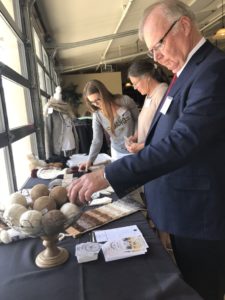
Idaho Department of Commerce Director, Tom Kealey, examines alpaca products from Grazing Hills Alpaca Ranch, Country Store and B&B in Viola, ID.
Washington is trying to help rural areas with this problem by establishing a statewide broadband office that would coordinate grants to governments and tribes for broadband infrastructure.
Washington 9th District Rep. Mary Dye, R-Pomeroy, told the Daily News in April that she and her colleagues in the House supported the legislation because it will increase competition in the internet service provider marketplace and bring better service to rural Washington.
In Idaho, Gov. Brad Little signed an executive order in May establishing the Idaho Broadband Task Force, Kealey said.
The 40-member task force this fall will bring to the governor recommendations on ways the state can improve connectivity and speeds across Idaho.
The task force will try to map existing services and gaps in broadband infrastructure, which Kealey said will paint a picture for what resources are needed in rural and urban areas.
“We want to map what we have, be able to measure what we have in terms of access as well as speeds and features and services and options,” he said.
Brown pitched another idea that may bring people and commerce to eastern Washington. In light of Microsoft and other corporations last year offering funding to build a high-speed railway from Vancouver, British Columbia, to Portland, Brown said she would like to see a similar railway that connects western Washington with eastern Washington.
“How fantastic that would be to connect our communities, to connect our students and families, and also as an opportunity for people to be able to leave the megalopolis and see what the options are in other parts of the state,” Brown said.
Brown and Kealey highlighted some positives in Washington and Idaho economies.
“If we were a country, we’d be up there with Sweden or Belgium right now,” he said.
Kealey said Idaho is near the top of the rankings in several economic categories including first in travel dollars, third in the number of people moving to the state and fourth in job growth.
The national coworking culture is now fifteen years old. Successful coworking spaces know they need to be more than just secure wifi, free coffee and meeting rooms.
“Coworking spaces have to go above and beyond to stay competitive and thrive—developing niches spaces for certain businesses (legal, fashion and beauty, blockchain, film production), offering unique experiences such as coliving or childcare, plus getting creative by opening spaces in underutilized real estate like hotel business centers or within stores.”
—Madison Maidment, COO of Coworker

Members of MosCoWork in Moscow, Idaho, have the option of renting dedicated desks or part time subscriptions.
One novel idea is an app that connects you with another local option: your neighbor’s living room. Codi, a new startup launching soon in the Bay Area of California, turns apartments and houses into temporary, affordable coworking spaces during the day.
“I used to work from home, and it’s very isolating. When you go to coffee shops, they can be very distracting. And there were no working options close by, and downtown coworking spaces are very expensive.”
—Christelle Rohaut, CEO/founder of Codi
LiquidSpace is a national online network that connects people with spaces. Users can search for meeting rooms, coworking space, private office suites, brainstorming-ready spaces, event spaces, and, dedicated desks. Searches can be customized to neighborhoods or specific properties to be the first to know of new space availability.
The list of coworking spaces in the Inland Northwest continues to grow, as rural communities recognize the need to attract flexible workforce and encourage a startup culture.
IDAHO CO-WORKING SPACES:
Bonners Ferry: The Plaza Downtown
Coeur d’Alene: The Innovation Den, SpaceShare CDA, Rockford Building
Hayden: Panhandle Area Council Business Incubator
Moscow: MosCoWork
Sandpoint: The Office Sandpoint
WASHINGTON CO-WORKING SPACES:
Liberty Lake: Liberty Lake Portal
Pullman: Crimson Commerce Club (C3)
Harrington: The Post & Office
Spokane: Niche Coworking, Fellow Coworking, Level Up, Regus, and StartUp Spokane
OTHELLO, Washington – In early May, McCain Foods USA Inc., a division of McCain Foods Limited, the world’s largest producer of frozen french fries, announced a $300 million investment in its Othello, Wash., potato processing facility, significantly expanding its North American production capacity. This 170,000-square-foot expansion will add another state-of-the-art battered and conventional french fry processing line to its production capabilities in the U.S. and bring an anticipated 180 new jobs to the community. Of note, this investment also brings environmental efficiencies, reducing the facility’s carbon footprint while doubling its production, underlining McCain’s commitment to sustainability.
“This investment signals confidence in Washington, its potato growing community and its skilled workforce availability,” said Jeff DeLapp, President, North America. “It quickly follows other McCain capacity investments, helping to meet the continued increasing demand for McCain products and builds toward a strong, sustainable future in manufacturing and agriculture.”
This added capacity will require an approximate 11,000 additional acres, sourced from local potato growers in the region, and follows a similar high-capacity expansion in Burley, Idaho to service the U.S. and global markets. Construction will begin this month with anticipated completion in early 2021.
About McCain Foods USA
McCain Foods USA is a leading supplier of frozen potato and snack food products for the foodservice markets, retail grocery chains and private label brands. Everything from appetizers to sweet potato fries can be found in restaurants and supermarket freezers across the country. McCain Foods USA Inc., headquartered in Oakbrook Terrace, Illinois, employs 4,000 people and operates production facilities in Idaho, Maine, Nebraska, Washington and Wisconsin.
For More Information, Contact:
Eric Benderoff | [email protected]
FOR IMMEDIATE RELEASE: May 24, 2019 (LIBERTY LAKE, Wash.)—Inland Northwest Partners announces their summer meeting to be held at Banyan’s on the Ridge (Palouse Ridge Golf Course) in Pullman on June 7, 9:00 a.m.-2:30 p.m., with a continental breakfast beginning at 8:30 a.m. Lisa Brown, Director of Washington State Department of Commerce and Tom Kealey, Director of Idaho Department of Commerce, will share the keynote presentation titled, “State of the States: Trends Shaping the Economies of Washington and Idaho.” Cost for INP members is $40, nonmembers is $60. To register, visit inwp.org/events.
The presentations of Directors Brown and Kealey will culminate a day of presentations under the theme of “Value-Added Agriculture: Cultivating New Jobs for Your Community”.
“Throughout the Inland Northwest Region, it’s exciting to see even more economic activity and job creation related to our strong agricultural sector from crop production, craft brewing, and agritourism.,” says Paul Kimmell, Chairman of INP Board of Directors. “It’s always great to showcase some of this success and continue to build on these opportunities.”
Other presentations include Chanel Twealt, COO for the Idaho Department of Agriculture, who will discuss agriculture as a regional economic driver; Dr. Laura Lewis, from WSU Food Systems, who will discuss the craft brewing and distilling industry; and, Adams County Economic Development Director, Stephen McFadden, who will discuss renewable energy, food processing and the cannabis industry.
Inland Northwest Partners members meet quarterly to share common economic challenges and solutions within the eastern Washington and northern Idaho region. Topics include technology, financing community initiatives, forging regional partnerships, local business expansion and retention, and job recruitment. INP often partners with local chambers or state organizations for value-added training.
Banyans on the Ridge is located at the Palouse Ridge Golf Course, 1260 NE Palouse Ridge Dr. in Pullman. For more information about becoming a member of Inland Northwest Partners, visit inwp.org or email [email protected].
************************
Inland Northwest Partners (INP) is a non-profit organization focused on enhancing the long-term vitality of a two-state region through its core offering of educational meetings, programs and seminars. More than 300 business and community leaders from eastern Washington and northern Idaho are members. INP is also part of a regional marketing effort known as the Inland Northwest Economic Alliance (INEA), a consortium of fourteen economic development agencies. To learn more, visit inwp.org.
WASHINGTON
Lisa J. Brown, Ph.D., was appointed Commerce Director by Washington Gov. Inslee and began serving the agency in February of 2019.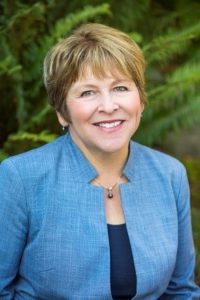 Prior to serving as Commerce director, Brown served as chancellor of Washington State University, where she led the health science campus in Spokane.
Prior to serving as Commerce director, Brown served as chancellor of Washington State University, where she led the health science campus in Spokane.
Brown served in the Washington State Legislature from 1996 – 2013 in the Senate where she was majority leader and chaired the Rules Committee, Ways and Means Committee, and Energy, Technology and Telecommunications Committee. She served in the state House of Representatives from 1993 – 1996, where she was minority whip and minority floor leader.
She has worked extensively on economic development in Eastern Washington and on gender equity.
Brown earned her bachelor’s degree in economics at the University of Illinois and her master’s and doctoral degrees in economics from the University of Colorado in Boulder.
IDAHO
Tom Kealey is Idaho Gov. Brad Little’s appointment to serve as Director of the Department of Commerce, and began his service in January of 2019. 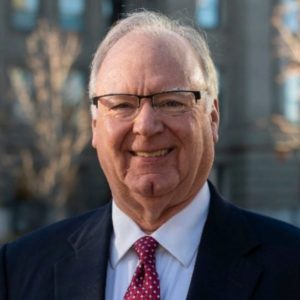 Kealey is co-owner of restaurant Chicago Connection and a former Morrison-Knudsen executive, and served on the Idaho Endowment Fund Investment Board under Governor Dirk Kempthorne.
Kealey is co-owner of restaurant Chicago Connection and a former Morrison-Knudsen executive, and served on the Idaho Endowment Fund Investment Board under Governor Dirk Kempthorne.
A lifelong Republican and retired CPA, Kealey believes in protecting the Idaho Constitution, taxpayers money and credit rating.
Kealey earned his accounting and finance degree from the University of Washington and an MBA in Strategic Planning and Marketing from Harvard Business School.
This post originally appeared on the Lincoln County Economic Development website.
(Davenport, WA, January 18, 2019) — It was early 2016 when the Harrington PDA began to install a high speed broadband network through their downtown business district. Now three years later, that project has become a model for do-it-yourself rural internet. Last January the stakeholders in the project were invited to tell their story to the State Senate Committee for Economic Development and International Trade. This past October Harrington hosted a policy discussion with Governor Inslee’s advisor on rural broadband, John Flanagan. And Last week Harrington’s Mayor Justin Slack spoke at a press event in Olympia where the Governor announced his 2019 initiative to increase broadband access throughout the state.
Mayor Slack spoke about the PDA’s project, but he also spoke about he and his wife Heather making the decision to move from Seattle to Harrington to raise their children in a small town. The Slack’s purchased a building within the fiber network so that Justin would have the bandwidth he needed to telecommute to his job with a Seattle bank. Soon the “accidental business owners” opened The Post & Office wi-fi coffee shop in the front half of their building and a fiber-fed shared workspace in the back. The Post & Office has become the hub of the community thanks to good coffee and high-speed internet.
Commissioner Scott Hutsell also spoke at the press event in Olympia. The Commissioner is the Chair of the Public Works Board, an infrastructure planning and funding board within the Dept. of Commerce and spoke about the importance of broadband. Inslee’s proposal includes $25 million in grants and bonds for broadband infrastructure and he hopes to see the Public Works Board administer those funds. The Governor also proposes the state establish a Statewide Broadband Office to be the central broadband planning body. Washington had a broadband office from 2009 to 2014, funded by a five-year federal grant from the American Recovery and Reinvestment Act, the same act that funded the NoaNet fiber project in 2012-2013. It is that NoaNet fiber that feeds Harrington’s network.

